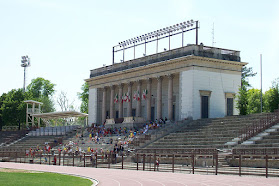Modena rider won titles in 125cc and 250cc categories
Luca Cadalora, the motorcycle racer who was three times a world champion, was born on this day in 1963 in Modena, Emilia-Romagna. Currently working as coach to Italy’s seven-times world champion Valentino Rossi, Cadalora began his professional motorcycle racing career in 1984, riding an MBA in the 125cc world championship. He picked up a respectable 27 points to finish eighth in his debut season, his best performance a second place in the German Grand Prix at the Nurburgring, but had a very disappointing second season, finishing only three races to collect a meagre four points. His switch to the Garelli team, the dominant force at the time in the 125cc class, catapulted him to fame. Cadalora and team-mate Fausto Gresini, his fellow Italian, battled it out for the title through the season, each finishing with four wins. Cadalora took the upper hand by winning four of the first seven races and it was his consistency over the campaign that clinched the title. He failed to complete only one of 11 races and finished in the top four in the other 10, finishing runner-up in his last three to pip Gresini by 114 points to 109. Read more…
______________________________________
Sandro Botticelli – painter
Renaissance master was forgotten until the 19th century
Early Renaissance artist Sandro Botticelli died on this day in 1510 in Florence. Years before his death he had asked to be buried in the Church of Ognissanti in Florence at the feet of a woman for whom it is believed he suffered unrequited love. She was Simonetta Vespucci, a married noblewoman, who had died in 1476. She is thought to have been the model for Botticelli’s major work, The Birth of Venus, which was painted years later in 1485, and that she also appeared in many of his other paintings. After his death, Botticelli was quickly forgotten and his paintings remained in the churches and villas for which they had been created until the late 19th century, when people started to appreciate his work again. Botticelli was born Alessandro di Mariano di Vanni Filipepi in 1445. He was active during the golden age of painting in Florence under the patronage of Lorenzo de' Medici and Lorenzo di Pierfrancesco de' Medici and was for a time apprenticed to both Fra Filippo Lippi and Verrocchio. In 1481 Botticelli was summoned to Rome by Pope Sixtus IV to paint three frescoes for the Sistine Chapel. Read more…
____________________________________
Giovanna Trillini - fencing champion
Four-times Olympic champion in foil
The Olympic fencing champion Giovanna Trillini, one of Italy’s most successful female athletes, was born on this day in 1970 in Jesi, a medieval town in the Marche region. Trillini won the individual gold medal in the foil event at the 1992 Olympics in Barcelona and was part of Italy’s gold-medal winning group in the team foil at Barcelona in 1992 as well as at Atlanta in 1996 and Sydney in 2000. She competed at five consecutive summer Olympics between 1996 and 2008 and her total medal haul of eight, including one silver and two bronze medals in the individual foil, makes her Italy’s fifth most successful Olympian and the third most successful female competitor. After winning individual gold in Barcelona, she was honoured by being asked to be the flag bearer for the azzurri team at the opening ceremony for the Games in Atlanta four years later. Trillini’s career also encompassed 19 medals in world championship events, including nine golds, and six in the European championships. Born into a sporting family, Trillini was encouraged to take up fencing by her two brothers, Ezio and Roberto, who were both regular competitors in the sport, in which Italy has a long tradition. Read more…
______________________________________
Federico II Gonzaga – Duke of Mantua
Ruler received a valuable education at the papal court
Federico Gonzaga, who became the ruler of Mantua and Montferrat, was born on this day in 1500 in Mantua. He spent his childhood living as a political hostage, first at the court of Pope Julius II in Rome and then at the court of Francis I of France. It wasn’t perhaps an ideal start in life, but historians believe the political, social and cultural education he received in the company of popes, cardinals, and kings helped shape him as a future ruler. Federico was the son of Francesco II Gonzaga and Isabella d’Este. His godfather was Cesare Borgia, Machiavelli’s model for the ideal Renaissance Prince. His father, Francesco, was captured by the Venetians during battle and held hostage for several months. While he was absent, his wife, Isabella, ruled Mantua. Francesco managed to secure his own release only by agreeing to send his son, Federico, to be a hostage at the papal court. After the death of Pope Julius II in 1513, Federico was sent to the court of the new King of France, Francis I, where he became a favourite, as he had interests in common with the King. After the death of his father in 1519, Federico returned to rule Mantua and established Isabella Boschetti as his mistress there. Read more…







_Gaetana_Agnesi.jpg)



.jpg)
.jpg)

_-_n._3901_-_Milano_-_Arena_(alternative_take).jpg)






.jpg)
.jpg)
.jpg)





%20(2).jpg)